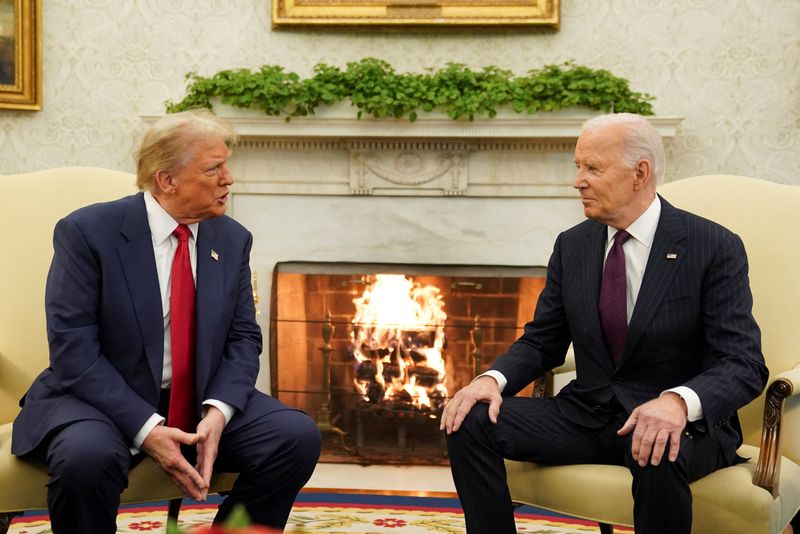(Reuters) – President-elect Donald Trump has pledged to repeal Joe Biden’s signature climate law, the Inflation Reduction Act. This law initially targeted about $400 billion in new spending and tax cuts and credits to accelerate America’s transition to a green energy economy.
The Congressional Budget Office expects costs to exceed $800 billion due to higher-than-expected demand for the tax credits; a large part of the direct financing has already been spent.
Repeal or renewal of the bill, which passed in August 2022 without a single Republican vote, would likely require an act of Congress. Industry groups, including utilities and some elected Republicans in Congress, are pushing to preserve credits for clean energy and other benefits, while the pharmaceutical industry is calling for adjustments.
Trump advisers have already made a series of recommendations that the Trump administration is expected to consider. Here’s how industries and consumers can be affected.
ELECTRIC VEHICLES: UNDER THREAT
The IRA provided $14.2 billion in incentives for purchasing zero-emission vehicles, such as electric vehicles, with income restrictions, and for installing alternative fuel equipment. It also created $2.9 billion in loans and grants for hybrid, electric and hydrogen cars.
Trump advisers recommend reallocating the money now flowing to building charging stations and making electric cars affordable national defense priorities.
Trump plans to end the $7,500 consumer tax credit for the purchase of electric vehicles.
The IRA has also provided $2.9 billion in loans and grants for the production of hybrid, electric and hydrogen cars.
The IRA provided $3 billion for zero-emission U.S. mail trucks. The Trump team is considering canceling contracts to electrify the fleet.
CLEAN FUEL AND EMISSIONS STANDARDS: UNCLEAR
The IRA has allocated $13.2 billion to promote clean hydrogen production and created $8.6 billion in new credits for low-carbon automotive and jet fuels, and expanded credits for biodiesel and other renewable fuels.
Aviation officials fear a rollback of green jet fuel credits and the Biden administration has yet to finalize the rules for the credits, and perhaps not before Trump takes office on January 20.
WIND, SOLAR, NUCLEAR: UNCLEAR
The IRA created $62.7 billion in new tax credits for zero-emission electricity sources and storage, including wind, solar, geothermal and advanced nuclear, and expanded $51.1 billion in existing tax credits for wind and solar energy.
It also created $30 billion in tax breaks to help shut down existing nuclear reactors.
Although Trump has expressed skepticism about wind and solar energy, no specific recommendations have yet been made for this part of the IRA. Employment and economic gains in Republican states have been high, making serious changes unlikely.
ENERGY INFRASTRUCTURE: UNCLEAR
The IRA has committed billions to modernizing the US’s overburdened power grid and bringing new forms of energy online.
It has spent $6.8 billion updating and expanding credit programs aimed at increasing efficiency in energy generation and transmission, created $3.2 billion in tax credits for carbon capture and storage and has 2, Provided $3 billion in loans and grants to finance electricity transmission, including offshore wind power generation. .
MANUFACTURE
The IRA creates $37 million in new incentives for companies to produce clean energy technologies in the U.S. rather than abroad, through tax credits and the Defense Production Act. The U.S. Treasury Department has also included related industries
It has also spent $5.3 billion to help reduce emissions from energy-intensive industries such as concrete production.
POOR, RURAL COMMUNITIES: UNCLEAR
The IRA is creating a $20 billion “Green Bank” for energy investments, focusing on poor and disadvantaged communities, and spending $14.8 billion on monitoring and reducing pollution, and on subsidies for disadvantaged neighborhoods.
It also includes $13.2 billion for investments in clean energy technology in rural areas.
ENERGY EFFICIENT BUILDINGS: UNCLEAR
The IRA establishes $9 billion in rebates and subsidies for residential buildings and extends and increases $37 billion in tax credits for energy-efficient properties.
AGRICULTURAL FINANCING: UNDER THREAT
The bill provides $16.7 billion in new funding for agricultural practices that improve soil carbon, reduce nitrogen losses and reduce emissions.
Republicans in the House of Representatives have proposed repealing $14.4 billion of this funding in a draft farm bill that would make the money available for a broader range of farm conservation practices.
CLIMATE RESILIENCE: UNCLEAR

The bill provides $4.8 billion to help reduce the risk of wildfires, $4.6 billion to combat droughts and $4.6 billion in investments in coastal areas and weather forecasting resources.
It also spends $4.2 billion on federal research and funding for FEMA, DOE and Homeland Security.


